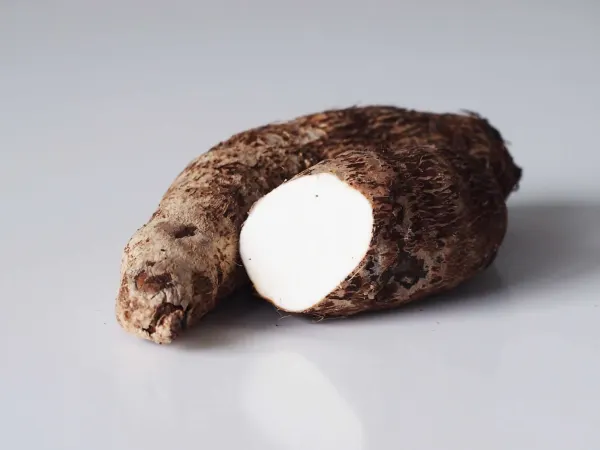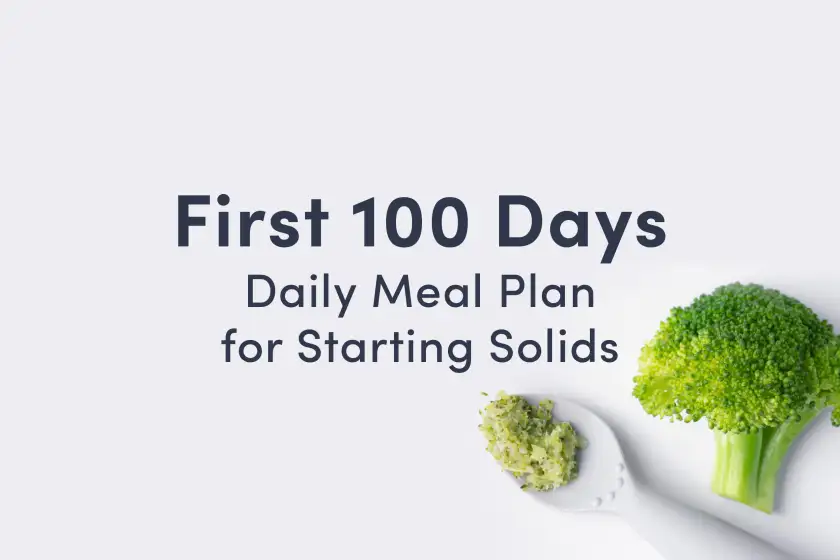Cassava (Yuca)
Vegetable
Age Suggestion
6 months
Iron-Rich
No
Common Allergen
No

When can babies eat cassava?
Cassava (also called bankye, khoai mi, mandioca, and yuca) may be introduced as soon as your baby is ready to start solids, which is generally around 6 months of age. Never serve or eat raw cassava (regardless of age) as the plant contains natural toxins that can cause serious health problems. To be safe for consumption, raw cassava must be processed into a food product (like cassava flour) or cooked until tender, which can take some time depending on the root's age and variety.
Background and origins of cassava
Cassava is native to Central and South America, where Indigenous communities first cultivated the tropical plant for its abundant roots, whose rich starches can nourish our bodies with energy-rich carbohydrates. European colonizers took the plant (and casabe, a hearty bread made by Indigenous people that keeps for extended periods) to Africa and Asia, where the root became an important agricultural crop. Today cassava joins maize and rice as a staple food for millions of people on our planet. The tuber’s tough bark-like rind protects pale flesh that is incredibly versatile as a food source. Just like potatoes and yams, cassava can be cooked in many ways (baked cassava! cassava chips! cassava fries! mashed cassava!) or processed to make cereal, flour, meal, or starch, otherwise known as tapioca. That’s right—we have cassava to thank for delicious sweets like boba tea and tapioca pudding!
Videos
Is cassava healthy for babies?
Yes—however, the plant contains natural toxins that must be broken down through the cooking process. Never serve raw cassava in any form to your baby or anyone for that matter, but also don’t let this stop you from exploring this tasty and important food.
Once it is cooked, cassava root offers lots of carbohydrates to fuel your baby’s body and plenty of vitamin C to support immunity and skin health. The root also contains a little potassium and trace amounts of calcium and iron.
Cooked cassava root and cassava products like flour, meal, and starch are excellent sources of carbohydrates—especially for gluten-free families—when served as part of a balanced diet. However, children who consume cassava as a dietary staple can be at risk for nutrient deficiencies. For families whose diets are built around cassava as the main food source, the addition of foods like legumes, meat, and vegetables can provide iron, zinc, protein, and other essential nutrients that kids need to thrive.
★ Shopping Tip: When purchasing whole cassava root, consider buying more than you think you will need. The fresh tuber has a short shelf life and it can be hard to tell if cassava has started to spoil due to its tough rind. Once skinned and cut open, compost any sections that contain dark or discolored areas. The flesh should be bright white and streak-free!
Is cassava a common choking hazard for babies?
No. Cooked cassava is not a common choking hazard, though tapioca pearls in boba drinks, puddings, and desserts can be. Tapioca pearls are not recommended for babies in general as they are highly processed and typically served with plenty of added sugars. As always, be sure to create a safe eating environment and always stay near your baby during mealtime. Check out our age-appropriate serving suggestions!
For more information, visit our section on gagging and choking and familiarize yourself with common choking hazards.
Is cassava a common allergen?
No. Cassava is not a common allergen, although allergic reactions are not unheard of, and individuals who are allergic to latex may be sensitive to cassava.
As you would when introducing any new food, start by offering a small quantity on its own for the first couple of servings. If there is no adverse reaction, gradually increase the quantity over future meals.
How do you prepare cassava for babies with baby-led weaning?
Every baby develops on their own timeline, and the suggestions on how to cut or prepare particular foods are generalizations for a broad audience.
6 to 9 months old:
Offer large sections of well-cooked cassava for your baby to eat as a finger food or mashed cassava that your baby can scoop with hands or eat from a preloaded spoon. As a reminder, never serve or eat raw or undercooked cassava.
9 to 12 months old:
Serve bite-size pieces of well-cooked cassava if your baby has developed their pincer grasp and consider continuing to offer large pieces of cooked cassava for biting and tearing practice. You can, of course, continue with mashed cassava as well, letting your baby eat with their hands or from a pre-loaded utensil.
12 to 24 months old:
Fork time! While you can certainly introduce a fork earlier, this is a great time to step up practice time with utensils. Serve bite-size pieces and show how to pierce them with a fork (making a “boink!” sound can help) and be prepared for your toddler to toggle back and forth between eating with utensils and their fingers. Mashed cassava, because it is thick and sticks to spoons well, is also great for independent spoon practice.
Once peeled, cut away and compost any sections that are dark or streaky, and use only flesh that is pure in color. Cassava flesh ranges from bright white to pale yellow depending on the variety.
Nervous about baby starting solids? Our virtual course leaves no stone unturned and will teach you everything you need to know about serving babies real food.
Written and reviewed by these specialists
J. Truppi, MSN, CNS
V. Kalami, MNSP, RD, CSP
K. Rappaport, OTR/L, MS, SCFES, IBCLC
S. Bajowala, MD, FAAAAI. Board-Certified Allergist & Immunologist (allergy section)
R. Ruiz, MD, FAAP. Board-Certified General Pediatrician & Pediatric Gastroenterologist
Expert Tips Delivered to Your Inbox
Sign up for weekly tips, recipes and more!
The content offered on SolidStarts.com is for informational purposes only. Solidstarts is not engaged in rendering professional advice, whether medical or otherwise, to individual users or their children or families. No content on this site, regardless of date, should ever be used as a substitute for direct medical advice from your doctor or your medical or health professional, nutritionist, or expert in pediatric feeding and eating. By accessing the content on SolidStarts.com, you acknowledge and agree that you are accepting the responsibility for your child’s health and well-being. In return for providing you with an array of content “baby-led weaning” information, you waive any claims that you or your child may have as a result of utilizing the content on SolidStarts.com.







